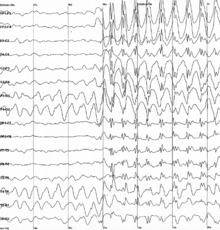
Back الصرع عند الأطفال Arabic אפילפסיה בילדים HE बच्चों में मिर्गी Hindi Epilepsitë dhe Konvulsionet në moshën fëminore Albanian
This article needs editing to comply with Wikipedia's Manual of Style. In particular, it has problems with not using MEDMOS. (June 2022) |

Epilepsy is a neurological condition of recurrent episodes of unprovoked epileptic seizures. A seizure is an abnormal neuronal brain activity that can cause intellectual, emotional, and social consequences. Epilepsy affects children and adults of all ages and races, and is one of the most common neurological disorders of the nervous system.[1] Epilepsy is more common among children than adults, affecting about 6 out of 1000 US children that are between the age of 0 to 5 years old.[2] The epileptic seizures can be of different types depending on the part of the brain that was affected, seizures are classified in 2 main types partial seizure or generalized seizure.[1]
Once a child has their first seizure or suspect seizure, they should be referred to specialized paediatrician in epilepsy and seizures to assess the seizure and conclude a diagnosis. The specialist doctor will take a detailed history of the child, perform physical examinations, clinical laboratory tests such as blood and genetic test, and neuroimaging. If the child is suspected of epileptic seizures, then additional investigations are to be performed such as, an electroencephalogram (EEG) which can give more information of the brain electrical activity and the seizure type.[3]
The epileptic seizure in the vast majority of pediatric epilepsy patients is ephemeral, and symptoms typically subside on their own after the seizure comes to an end, but some children experience what is known as a “seizure cluster," in which the first seizure is followed by a second episode approximately six hours later. These recurrent seizure episodes pose a higher risk of death for children.[4]
Children should be treated with proper and effective therapy to prevent irreversible neural damage.[5] Treatment options for epilepsy include medications, diet, and surgery.[6] Diet and surgery are considered for children who have medication resistant epilepsy.[7]
Epilepsy is classified according to seizure types, epilepsy types, and epilepsy syndromes. The seizure types include focal onset, generalized onset, and unknown onset,[8] while the epilepsy types include focal, generalized, combination focal and generalized, and unknown. Accurate classification of epilepsy will help in providing an appropriate treatment and management therapy.[9]
- ^ a b Cite error: The named reference
Seizures and Epilepsy in Childrenwas invoked but never defined (see the help page). - ^ Rollison J, Partikian A, Akinniranye G, Yagyu S, Motala A, Hempel S (2019-12-30). "Topic Brief: Infantile Epilepsy" (PDF). Patient-Centered Outcomes Research Institute.
- ^ "Diagnosis and assessment of epilepsy | Epilepsies in children, young people and adults | Guidance". www.nice.org.uk. 2022-04-27. Retrieved 2023-07-25.
- ^ Leviton A, Patel AD, Loddenkemper T (July 2023). "Self-management education for children with epilepsy and their caregivers. A scoping review". Epilepsy & Behavior. 144: 109232. doi:10.1016/j.yebeh.2023.109232. PMID 37196451.
- ^ Minardi C, Minacapelli R, Valastro P, Vasile F, Pitino S, Pavone P, et al. (2019). "Epilepsy in Children: From Diagnosis to Treatment with Focus on Emergency". Journal of Clinical Medicine. 8 (1): 39. doi:10.3390/jcm8010039. PMC 6352402. PMID 30609770.
- ^ Treadwell JR, Wu M, Tsou AY (2022-10-25). Management of Infantile Epilepsies (Report). Agency for Healthcare Research and Quality (AHRQ). doi:10.23970/ahrqepccer252. PMID 36270899
- ^ Cite error: The named reference
:2was invoked but never defined (see the help page). - ^ Fisher RS, Cross H, French JA, Higurashi N, Hirsch E, Jansen FE, et al. (8 March 2017). "Operational classification of seizure types by the International League Against Epilepsy: Position Paper of the ILAE Commission for Classification and Terminology". Epilepsia. 58 (4): 531–542. doi:10.1111/epi.13670. hdl:11343/292620. PMID 28276060. S2CID 21037500.
- ^ Perucca P, Scheffer IE, Kiley M (March 2018). "The management of epilepsy in children and adults". The Medical Journal of Australia. 208 (5): 226–233. doi:10.5694/mja17.00951. PMID 29540143. S2CID 3910434.
© MMXXIII Rich X Search. We shall prevail. All rights reserved. Rich X Search